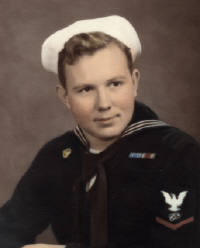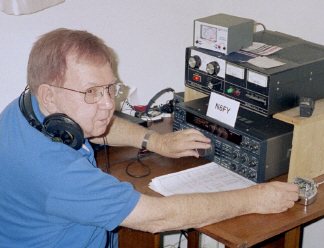More About Fred Field, N6FY
N6FY, ex K6IHY, W3UVU, W4LLI
During grade school I developed an interest in electricity and radio. I was encouraged to read and experiment by my 6th grade science teacher, Miss Susie Floyd. Although I built several crystal sets, my involvement in radio did not get really serious until I entered Newport News High School in September 1941. The school had a good library with some books on radio.
 |
1947 and fresh out of the Navy. W4LLI is very active in Hampton on 80 and 10.
 |
2004, 57 years and 3 callsigns later. Still active as N6FY in California.
|
|
I had been aware of amateur radio, but did not know of anyone licensed except Frederick E. Royall, W3HGK. He lived near me on the Boulevard, but died suddenly before I could arrange to meet him.
Unfortunately, World War II began only a few months into my freshman year of high school. As of early December, all amateur radio operation was closed down. I continued my interest and managed to build working circuits up to a two-tube regenerative receiver for the broadcast band. During my junior year I taught myself morse code. This was done the hard way - by sheer memorization. Then I found that I could pad the variable capacitor on my broadcast regen. and hear maritime and military cw traffic on 425 to 500 kHz. I couldn't copy everything I heard, but I did make progress. By my senior year I was buying copies of QST and devouring every word.
I turned 17 on June 7, 1945 - the day I graduated from high school (we only went to school 11 years then). The war was still on and I went to work in the Shipyard as an Electrician's Helper. In September the war abruptly ended. Soon after, I ran into an old friend who told me that the FCC had opened up two ham bands and that he knew an operator who was already on the air. That friend was Jimmy Gregory, who today is W3OPD in Maryland. I scrambled to get an introduction to this real live ham. He turned out to be Curtis Bryant (now SK) then W3GGP and later W4JIA. Curt lived at 120 29th St. in Newport News. When 10 meters was restored, Curt was quickly on the air with about 60 watts phone and a 3-element beam.
Curtis was about the nearest I came to having an "Elmer." He taught me how to use the key and critiqued my sending. And he patiently went over an old license manual, making sure that I not only knew the answers, but thoroughly understood all the theory.
Suddenly an opportunity came along which allowed me to enlist in the Navy with a guaranteed entry into electronics school. That put ham radio on the shelf for a while, but as soon as I was through basic training I began to think again about getting licensed. Upon starting the electronics school at Great Lakes, IL, I met a fellow student, Frazier Phillips, who was already licensed as W8WOC. He offered to give me the Class C license exam, which in those days was the usual entry path for those in the military. His code test was probably harder than anything the FCC would have given me, but I passed ok. Unfortunately the Base Commander hated amateur radio and would not sign the form for a station license, so I got an operator-only ticket and no call sign..
Shortly after getting licensed, I met another ham, John Brett, W2QPJ. I offered to buy parts to put together a station and together we built up a 3-tube regen. receiver, and a one-tube (6L6) transmitter. We rented a garage outside the Naval Base and went on 80 meter CW with our one crystal.
After finishing up the Navy primary school, I was transfrerred to Washington DC for advanced courses. During a short leave in Dec. 1946 I went to the FCC office in Norfolk and passed the class B license exam. W4LLI was issued to me on Jan. 31, 1947. On the first weekend visit home, I got out my 80 meter rig and went on the air. The first contact was arranged with Curtis Bryant, and took place on Feb. 8, 1947. For the next six months all of my operation was from my parents' home at 38 Apple Ave. The tiny lot did not have much antenna room, so each weekend I tossed a temporary wire over the house and trailed it off down the alley on top of a fence.
By the summer of 1947 I had begun building a 10 meter phone rig. This had an 807 final and was modulated by a pair of 6V6s. Progress was slow because I had been put aboard a destroyer and got home only when my ship was in Norfolk. In Dec. 1947 I received my discharge from the Navy and within two days had the phone rig finished and on 10 meters. I am proud that my first ever phone contact was with W4MT.
My first PARC meeting was in January, 1948. The speaker was Bert Aaron, now WA2IEI, then W4JXH, and pre-war W3IED. Bert spoke on converting a surplus SCR-522 VHF transmitter to 10 meters. All of us younger hams salivated as he showed off his 10 meter mobile which was neatly installed in his new convertible. Bert was my co-speaker at our PARC presentation in October, 2000. My log shows a 10 meter phone contact with Bert on Jan. 11, 1948.
A very fortuitous event took place at that first PARC meeting. My friend Jimmy Gregory introduced me to Stan Howell (then W4KDV, later W6MTY and recent SK). Stan was Chief Engineer at the fledgling Hastings Instrument Co. I explained to Stan that I was just out of the Navy and was looking for a job in radio. Stan arranged an interview with Charles Hastings and a few days later I was the company's 12th full time employee. That wonderful connection lasted throughout my college days and I always had a much-needed summer job waiting for me.
After graduating from Virginia Tech in 1952 I left the Peninsula area for a job in Baltimore where I became W3UVU. In 1954 I accepted a job in Southern California and became K6IHY (and later N6FY). I have been here ever since.
|
|